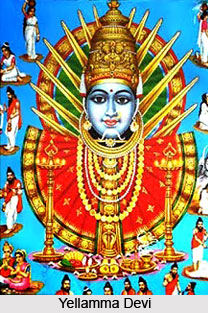 The Basvi system is deeply rooted into social customs and religious traditions. This custom of initiating girls to temples prevailed in the third century. They were regarded as eternal brides of the gods. In Karnataka the Basvis are dedicated to Yellamma or the Adi Shakti or Sarvamba.
The Basvi system is deeply rooted into social customs and religious traditions. This custom of initiating girls to temples prevailed in the third century. They were regarded as eternal brides of the gods. In Karnataka the Basvis are dedicated to Yellamma or the Adi Shakti or Sarvamba.
Origin of the Basvi System
The origin of the Basvi system can be dated back to the glorious period of Veerashaivism. This period prevailed during the 12th century. This system took its original form among the Vokkaliga and Komati castes. Gradually it became prominent among the Vaishnavites. In those days, the girls were initiated only to gods and not goddesses.
Types of Basvis
There are different types of Basvis that have been stated below:
1. Goodu basvi: She is also known as Orabasvi. It means that she is the wife of the principal deity of that village. After retiring as a basvi she needed to nominate her niece as her successor who would then carry out the religious duties.
2. Jati basvi: She is a caste basvi or Jati basvi.
3. Balagada basvi: In this type the couple who are not blessed with any male children dedicate one of their daughters as a basvi. The girl is then required to propagate their progeny. The children of the basvi belong to the same family.
4. Ora basvi: The Basvi here belongs to the village. Ora Panduga is also performed and Basvi is the `priestess`.
5. Garuda basvi: Those who are dedicated to Lord Vishnu are known as Garuda Basvis.
6. Linga basvi: Those who are dedicated to Lord Shiva are known as Linga Basvi.
Apart from these basvis, there are many other types of basvis such as Divatige Basvi, Yade Basvi, Hennu Basvi, Bala Basvi and Batla Basvi. Divatige Basvi is required to bear the sacred torch when the deity is taken out for a procession. Yade Basvi carries the Naivedyam to the deity. She holds the right to have a share of the sacred food. Another type of basvi is Hennu basvi. This type of basvi existed in the erstwhile state of Mysore. The word `Hennu` means female. When she is dedicated to a village deity, she is called `Hennu basvi`. A Bala Basvi is one who belongs to the Mahar community. The Bala Basvis are still found in some villages of North Karnataka. They are handsomely rewarded by the temple authorities as well as from the community.
Initiation Ceremony of Basvis
In case of basvis, the initiation ceremony meaning the wedding of the girl takes place at the tender age of 8 to 10 years to some deities like Anjaneya, Lord Venkateswara, Mallayya, Muniswami, Rangaswami, Vrukonda Veeranna, Durgamma, Ellamma, Kolhapuramma, Mahalakshmi, Maremma, Tayamma, Tikka Lakshmamma and Uligamma. The dedication ceremony of the Basvis requires a huge preparation. The parents who wish to dedicate their daughter need to make many arrangements. Many friends and relatives are invited for the ceremony. The girl wraps her body with leaves of neem tree and worships the deity. She is made to sit in front of the deity. She is adorned with a necklace of black or white beads and gold mangalsutra is tied around her neck. This is done by the caste priest of Madigas or maternal uncle Bayannayana or Goravaiah, if she is a devotee of Lord Siva. The ceremony comes to an end with the priest being given a gift, followed by a non vegetarian feast. A ram or a goat is sacrificed to the deity.
The girl who is dedicated as a basvi remains a concubine throughout her life. She is also supposed to take part in the jatara. The basvi has to undergo re-initiation ceremony before the wedding of her son in order to ward off a calamity. While doing so she has to circumambulate the shrine wearing neem leaves and also host a non vegetarian feast too. The initiation process to the male deities is quite cheap. Animals are not sacrificed here and the procedure is also very simple. The prospective basvi wears a white dress and is decorated like a bride. Rangavalli is drawn where she sits and the taliis tied by the priest or by the maternal uncle. Sometimes, the initiation process takes place at the basvi`s home.
Factors of Basvi System
Basvi system is still prevalent in many places. The few obvious factors for the prevailing systems are:
(1) Superstition: People who live in unhealthy environment often suffer from various diseases. They believe that these can only be cured if the goddess is appeased. Dedication, they believe, is the only way to appease the goddess.
(2) Poverty: The quagmire of poverty has forced many parents to initiate their daughters into the Basvi system. These women support their parents in their old age. A girl who is made a `Basvi` is almost equal to a male earning member of any family.
(3) Dowry System: Many parents also initiate their draughts into the Basvi system as they do not have the capacity to give dowry at the time of marriage.
The Basvi system is thus practised in South India and other places where the girl needs to practise many religious activities and offer her prayers to the goddess to whom she is initiated.




















